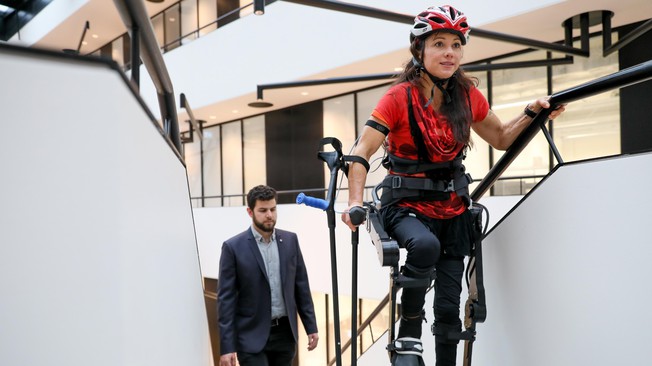
TWIICE One Exoskeleton is a Step Towards Independence
The new version of the TWIICE walking-assistance system is not only lighter, more comfortable and more powerful, but patients can also put it on and use it themselves – giving them greater independence. It has been tested by handcycling champion Silke Pan.
Silke Pan – a former acrobat who lost the use of her legs after a trapeze accident – arrives at the lab in a wheelchair. Using her considerable arm strength, she lifts herself out of the wheelchair and into a small stool, but on which sits a device consisting of two “legs” finely crafted from carbon fiber and aluminum. She carefully places one leg, then the other, inside the device, closes the Velcro fasteners around her feet, locks the fasteners around her thighs and straps the battery pack onto her back. With the help of crutches that provide stability and house the controls for the device, she pulls herself up to her feet. Then, thanks to the device – the latest version of the TWIICE exoskeleton – she starts to walk.
Pan, who is Swiss, became a handcycling champion after her accident. In 2016 she began working with scientists at EPFL’s Robotic Systems Laboratory (LSRO) to develop the TWIICE lower-limb exoskeleton that can help paraplegics walk again.
Her valuable input allowed the scientists to create a robotic structure that can fully support the weight of a human body and guide the person’s steps. Their TWIICE design won 4thplace at the 2016 Cybathlon in Zurich and took home the gold medal at the 2017 Cybathlon in Dusseldorf.
A crucial advancement
In 2018, two years after the initial exoskeleton was developed, the scientists introduced a new version called TWIICE One. It is narrower and lighter, twice as efficient and most importantly “gives us even greater independence,” says Pan. That’s because patients can now put on and take off the exoskeleton by themselves. This enhanced autonomy is a crucial step forward for Pan, who – even though she almost always has someone by her side for safety reasons – appreciates being able to do things on her own.
Like the previous version, TWIICE One has two electric motors on each leg that enable patients to move their hip and knee joints. But in the new design the actuators are integrated into the structure, making it less cumbersome and easier to manipulate. The new design also delivers twice as much torque as the old one and is half as voluminous.
However, it weighs the same – 16 kg – and has the same three-hour battery life. A control device in one of the crutches allows patients to choose among three walking speeds and go up and down stairs. “Walking requires less strength, but you still need to concentrate fairly hard to keep your body upright,” says Pan.
Promising initial trials
Two companies have teamed up with EPFL to develop the prototype. “This project with LSRO and the TWIICE research team challenged us to develop powerful yet ultra-compact actuators for moving the exoskeleton,” says Olivier Pajot, Sonceboz Innovation Cell Manager at EPFL’s Innovation Park. “The solution we came up with is integrated into this new version, which Silke tested and which has already delivered promising results in the initial trials.”
“We’re proud to have been working with EPFL and the TWIICE research team for the past three years now on exoskeleton development,” says Jonathan Brossard, CEO of Fischer Connectors, a manufacturer of high-performance connectors.
“This project is particularly important to us because it can improve people’s day-to-day lives. It also shows how we are able to conceive new applications for connectors and develop systems jointly with our customers that can enhance the quality of life of thousands of individuals.”
A startup and the 2020 Cybathlon
“Now we need to put our technology to the test and find a way to give more people access to these kinds of walking-assistance systems,” says Mohamed Bouri, head of the research project at LSRO. PhD student Tristan Vouga adds: “We need to test the system’s robustness and strategy, and measure the improvements in patients’ independence and ability to get around on a day-to-day basis.” The scientists also want to enhance the TWIICE user experience, such as with more seamless walking methods and sensors that can detect obstacles in front of a patient.
The next step for the research team is to develop and market this technology. They are in the process of creating a startup – also called TWIICE – to produce and sell the exoskeletons, which for now are still being made on a customized basis. The goal is to reach as many people in need of such walking-assistance systems as possible. And as for future competitions, the team has already signed up for the 2020 Cybathlon.
Materials provided by Ecole Polytechnique Fédérale de Lausanne.
Mediacom







Leave a Reply